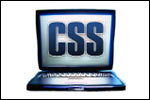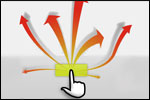Posts Tagged ‘html’
 We have already discussed CSS selectors that could be used without worrying about browser support in our previous articles. Now we are going to talk about the selectors that can quite useful in some browsers, but fail to work cross-browser. If you are going to style document, the selectors explained can help you a lot.
We have already discussed CSS selectors that could be used without worrying about browser support in our previous articles. Now we are going to talk about the selectors that can quite useful in some browsers, but fail to work cross-browser. If you are going to style document, the selectors explained can help you a lot.
Continue Reading...
Next post
Previous post
 It is not so hard to write rules for a specific document, the other thing is to write CSS for entire site. It is advisable to verify that when a context is defined, it is necessary for an element to appear within that context to receive its defined style. In css, pattern matching rules determine which style rules apply to elements in the document tree.
It is not so hard to write rules for a specific document, the other thing is to write CSS for entire site. It is advisable to verify that when a context is defined, it is necessary for an element to appear within that context to receive its defined style. In css, pattern matching rules determine which style rules apply to elements in the document tree.
Continue Reading...
Next post
Previous post
 Classes help you to structure your document as well as add semantic meaning to elements where html falls short. It is better not to apply too many classes on one single element and avoid classes that contain behavior instead of semantic meaning. In case you use the class attributes correctly, you will get flexible and future proof structure to your documents.
Classes help you to structure your document as well as add semantic meaning to elements where html falls short. It is better not to apply too many classes on one single element and avoid classes that contain behavior instead of semantic meaning. In case you use the class attributes correctly, you will get flexible and future proof structure to your documents.
Continue Reading...
Next post
Previous post
 Trying to be a professional web designer we try to learn everything necessary about web standards and even more. Now you know a lot about screen readers and people with disabilities browsing the web, how machines differ from humans as well as about semantics and syntax. All this is quite useful.
Trying to be a professional web designer we try to learn everything necessary about web standards and even more. Now you know a lot about screen readers and people with disabilities browsing the web, how machines differ from humans as well as about semantics and syntax. All this is quite useful.
Continue Reading...
Next post
Previous post
 At-rules are instructions or directives to the CSS and can be used for a variety of purposes. There are quite a lot of facets specific to the page at-rule. However, many at-rules don’t work on any browser, so we offer you the basic information concerning at-rules that help you to get the idea without wasting your time on reading a lot of stuff.
At-rules are instructions or directives to the CSS and can be used for a variety of purposes. There are quite a lot of facets specific to the page at-rule. However, many at-rules don’t work on any browser, so we offer you the basic information concerning at-rules that help you to get the idea without wasting your time on reading a lot of stuff.
Continue Reading...
Next post
Previous post
 Here you can find some general information about position and floating. The main issue of this article is the larger chunks of a page. However, you can represent any web design with the right combination of positioning, floating, margins, padding and borders. Just look at each part of the page as individual chunk.
Here you can find some general information about position and floating. The main issue of this article is the larger chunks of a page. However, you can represent any web design with the right combination of positioning, floating, margins, padding and borders. Just look at each part of the page as individual chunk.
Continue Reading...
Next post
Previous post
 There’s nothing special about how most of HTML elements work. Thus, you can make up most pages from a few tags that can be styled as you wish. The browser’s default visual representation of most HTML elements consist of varying font styles, margins, padding and display types.
There’s nothing special about how most of HTML elements work. Thus, you can make up most pages from a few tags that can be styled as you wish. The browser’s default visual representation of most HTML elements consist of varying font styles, margins, padding and display types.
Continue Reading...
Next post
Previous post
 Without specifying a doctype, your HTML is not valid and most browsers will switch to ‘quirks mode’. In other words, the browsers will think that you just don’t know what you are doing and decide what to do with your code on their own. Even perfect CSS is nothing without a document declaration as well as with a wrong document declaration.
Without specifying a doctype, your HTML is not valid and most browsers will switch to ‘quirks mode’. In other words, the browsers will think that you just don’t know what you are doing and decide what to do with your code on their own. Even perfect CSS is nothing without a document declaration as well as with a wrong document declaration.
Continue Reading...
Next post
Previous post
 The accessibility for forms is important issue to consider for making site attractive for the users with disabilities, especially for those who are blind or visually impaired. Thus, it is better to add a number of elements to the form to improve the process of imputing information.
The accessibility for forms is important issue to consider for making site attractive for the users with disabilities, especially for those who are blind or visually impaired. Thus, it is better to add a number of elements to the form to improve the process of imputing information.
Continue Reading...
Next post
Previous post
 Your website should be accessible to all Internet users notwithstanding the browser they use. An accessible link imparts as much information to as many users as possible. Thus, the reader can preview the link before make a decision whether to follow it or not. Here you can find useful information that helps you to make links more accessible.
Your website should be accessible to all Internet users notwithstanding the browser they use. An accessible link imparts as much information to as many users as possible. Thus, the reader can preview the link before make a decision whether to follow it or not. Here you can find useful information that helps you to make links more accessible.
Continue Reading...
Next post
Previous post
 We have already discussed CSS selectors that could be used without worrying about browser support in our previous articles. Now we are going to talk about the selectors that can quite useful in some browsers, but fail to work cross-browser. If you are going to style document, the selectors explained can help you a lot.
We have already discussed CSS selectors that could be used without worrying about browser support in our previous articles. Now we are going to talk about the selectors that can quite useful in some browsers, but fail to work cross-browser. If you are going to style document, the selectors explained can help you a lot. 







